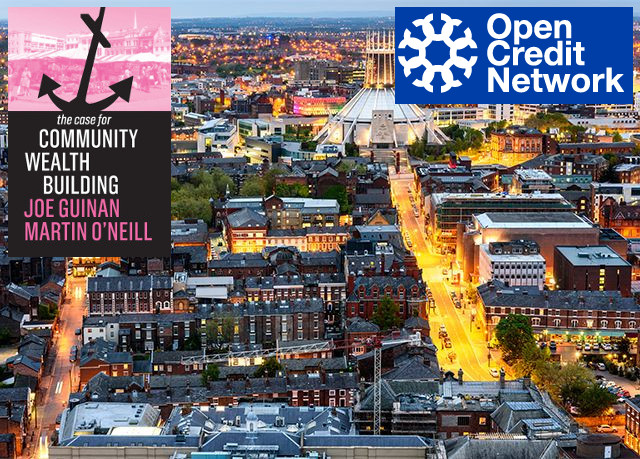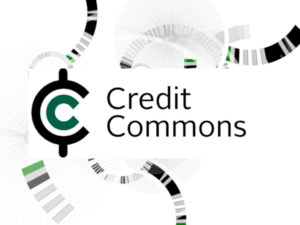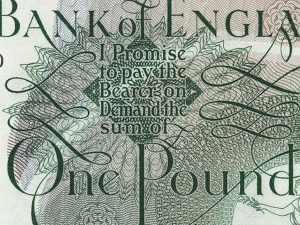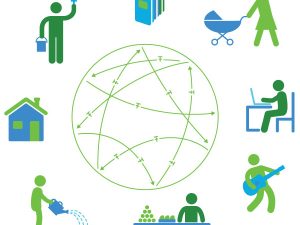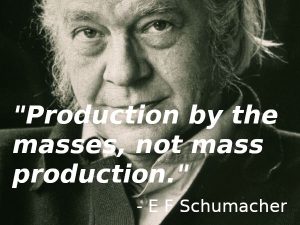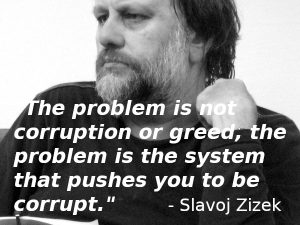This is the third in a series of articles about community wealth building and mutual credit, by Dave Darby and Dil Green of Lowimpact.org and the Open Credit Network.
Mutual credit
Mutual Credit is a payment system which operates through rolling credit on the basis of a degree of trust. In varying forms, it has a long pedigree. As David Graeber lays out in his ‘Debt – the first 5000 years’, versions of credit-based, open currencies have been the typical system throughout much of history, only being supplanted by debt-based and increasingly centralised, enclosed currencies in the last few centuries.
Our modern currencies have not been designed, but rather co-evolved with the economic system – one based on extraction, accumulation and eventually financialisation – where the accumulation and control of money is the key driver – rather than value production in the service of human desires.
Modern Mutual Credit systems are not blindly evolved from earlier forms. They have rather been carefully and consciously designed, drawing on two strands of learning – the economic works of (among others) EC Riegel, Bernard Lietaer on the one hand, and the direct experience of practitioners like Thomas Greco, Michael Linton, Tim Jenkin and Matthew Slater. Further, software implementations of these systems in conjunction with the internet greatly increase reach and utility while reducing transaction costs.
Mutual Credit is a medium of exchange, but not a currency as such. There is a ledger which records transactions measured in bank money units. As long as members give as much as they receive in the long run, no money is required. Not settling every payment with money though, requires trust that everyone will balance their account – that buyers commit to redeem credit through future value creation, and equally that sellers recycle these credits by buying from other members. The key requirement is the establishment of this trust – in the capacity of network members, acting together, to manage the network (usually with a service partner) to assign balance limits to members and control a few other key parameters.
The numbers in a Mutual Credit member’s account are not commodities, but quantified relationships: at the point of exchange, the seller’s account is credited, the buyer’s debited. The overall balance of a network is always zero – the positive and the negative are tracked through the system until they can be redeemed against each other. The tendency of the currency system is to return to balance, as members are required continually to balance buying with selling in order to maintain their ability to trade.
The systemic feedbacks of an exchange system that works like this reward flow, rather than accumulation. Since Mutual Credit is not a debt, but a promise, there is no question of interest, and there is no inherent scarcity – and therefore no incentive to hoard. This means that wealth in the context of a Mutual Credit Economy is experienced through higher volume of value creation, rather than accumulation of money tokens.
Community wealth
With a centralised bank currency in an increasingly financialised system, ‘community wealth’ can have a hollow ring to it. If measured in money, where is the money to be kept? The only possible current answer to this question is; ‘in the financial system’ – which is emphatically and increasingly not local. The experiences of many LAs after the 2008 crash with holdings in various financial institutions exposed this reality in often painful ways.
If we consider community wealth rather as some mix of vibrant local trading relationships, local value producing capacity and local economic resilience, it is much harder to deposit in a foreign bank and lose on the global casino. But if all of these conditions are mediated and transacted with bank currency, then constant and active mitigation of the extractive tendencies of that currency system is required. Such mitigation, clearly, can only be achieved through policy, and here we encounter a range of problems.
Policy is very properly a matter of politics, and current politics in the UK is increasingly centralised, with the freedoms and scope of LA action further and further constrained over the last decades under all flavours of government. Further, centralised control is increasingly expressed in terms of control over spending – ring-fenced grants, centralised determination of local taxation, increasingly specific performance targets tied to funding and the like.
There is also an issue of timescale. Politics has short timescales – less than a decade, while local economy building has a more generational periodicity. If policy is all that stands between the community wealth and the inimical characteristics of the financial system, then it is no surprise that successful community wealth building approaches tend to be found in ‘one-party-state’ LAs where businesses can have sufficient confidence in continuity of policy to risk significant engagement. A more general experience, for local businesses, is that a policy-driven initiative is not fully delivered upon.
Mutual credit and community wealth
Since Mutual Credit depends upon trust between peers, they are always local, and always require some degree of community self-awareness. So from the outset, there is clear alignment between the way that economic relations are mediated and transacted, and the aims behind community wealth building (there are of course, varieties of ‘local’ that do not depend upon geography – such as industry horizontals and verticals – and different scopes, too – from neighbourhood to bioregion).
This apparent congruence is encouraging, but we need to look at the specific systemic drivers that incentivise the behaviour of the participants in a Mutual Credit network to see how these tend towards the strengthening of the three characteristics mentioned above – vibrant local trading relationships, local value producing capacity and local economic resilience.
Vibrant Local Trading Relationships
Members of a Mutual Credit network have the option to trade within that network or not, and to use bank currency or Mutual Credit in any proportional mix when they do trade within it.
But if they trade with other network members, and use Mutual Credit, then several things happen;
- Most immediately, they will improve their cashflow with respect to bank money – Mutual Credit trading can mitigate cashflow problems and consequently reduce their cost of finance / increase their trading opportunities.
- Trade within the network is less risky – members need to maintain their trustworthy reputation in order to access credit. Thus the tendency over time is for the risk of trade within the network to be lower in comparison to trade outside the network.
- Increased trade within the network will result in increased trust and therefore increased credit – giving additional capacity to mitigate cashflow issues.
- Since trade within a network needs to be balanced, there will be incentives to bring a variety of businesses into the network in order to increase the variety of trading partners.
- Since a large positive balance is a large pile of promises from a relatively small, local network, it will be seen by accountants and CFOs as a risky holding – successful sellers into the network will wish to be active buyers within the network, too. Thus what is prioritised within the network is active trading, rather than accumulation. The incentive for all members is towards higher velocity and volume – which translates directly into additional local value production.
Local Value Producing Capacity
If local Mutual Credit networks support increased turnover and mitigate cashflow issues, and the demand for services is more sure (since other network members also have better cashflow) then access to investment finance from banks will be easier.
A further development of Mutual Credit economies is a proposal around local investment in common capacity building initiatives on the basis of ‘use-credit-obligations’, but that is a separate topic.
Local Economic Resilience
In the globalised economy, supply chains are long – a shockingly small proportion of local consumption is supplied by local productive capacity. This means that nonlocal money – bank money – is always needed to provide the spending power to buy in the large proportion of needed goods and services which are not locally produced.
But since the bank money economy is also globalised, access to that spending power is largely divorced from local value producing capacity. In a recession, cash is short, even while productive capacity and needs remain as they were before the recession.
If a local Mutual Credit network exists, then the spending power of members in relation to other members of that group is insulated to some extent from global conditions. Thus, in recessionary times, with a Mutual Credit Network in place, local trade – both buying and selling – is attractive to members; Mutual Credit can have a counter-cyclical effect.
It is important, though, to note that this spending power can only safely be exercised in respect of the ‘circular’ trade within that network – for an approach to this issue see ‘The Credit Commons’, below.
Circular money for a circular economy
So far, we have considered Mutual Credit from a purely value-production angle. This is insufficient. In the overarching context of the climate crisis, no significant action should be undertaken without consideration of its capacity to mitigate the destruction of the biosphere that threatens our civilisation.
Here, too, Mutual Credit has strong inherent characteristics which are positive.
In the discussion above, it is made clear that the extent of trade within a Mutual Credit Network is constrained by the ‘circularity’ of that trade. Since promise made must be redeemed for the system to work, buying and selling must balance over time.
In an economy of long supply chains, starting with extraction at one end, and the dustbin (recycling bin, more optimistically) at the other, circularity of trade is not emphasised, but rather verticals, each step adding a little value, until the product arrives at the consumer, while the money flows in the opposite direction. The drive in this economy is the accumulation of money units – and this requires continuous extraction – of ‘externalities’ at one end, and labour power at the other. Value production is considered a necessary cost along the way, but is seen as the route to accessing money, rather than the primary purpose. The economy has become a machine for turning the biosphere into money tokens.

In a Mutual Credit Economy, by contrast, accumulation of units in an account is not emphasised, but rather value production itself. Since one’s preferred trading partners are in the network, and wealth looks like increased rates of value production (giving increased access to the value production of others), and since this works best when it is locally ‘circular’, there is an incentive for a network to grow in two directions:
- Increased local circularity – which means increasingly accessing both suppliers and customers locally.
- Increased local capacity – to increase circularity, you need a sufficient range of producers – if one is missing locally, then there is a business opportunity waiting to be filled.
Since the limit to both of these is access to materials (raw or processed) not available locally, then the tendency, over time, will be towards increasing the local capacity to add value to what is available locally. To more human value-adding work, with less material.
This is what is typically meant when the term ‘circular economy’ is used with a ‘green’ intent; the development of an economy which satisfies human desires increasingly through added value, rather than with an endless supply of extracted raw materials.
However, most ‘Circular Economy’ advocates again rely on policy drivers. This is understandable – while economic relations are mediated and transacted using bank-money, this is probably the best bet.
By contrast though, Mutual Credit Economies embody bottom-up, endogenous drivers towards more circular economies, and at the same time improve local wealth and economic resilience.
The Credit Commons
Of course, all this focus on localism is just that – a focus. It is neither expected, nor desirable, that local economies should become entirely self-sufficient, entirely self-contained. The purpose of an economy, after all, is to support diversity, to support specialisation, to allow humans to flourish in myriad ways. To build civilisation.
So while local circularity of trade needs to be significantly increased beyond the current desperately weakened condition, this won’t be achieved overnight, and the baby must not be thrown out with the bathwater.
Firstly, particularly at the outset, local ‘circularity of trade’ will be low – perhaps as low as a few percent of a local economy has potential to be circularised relatively quickly.
This will mean that Mutual Credit Networks need careful management and inception at the outset, and should not be oversold. Members will need to understand what proportion of their trade is safe to conduct in Mutual Credit units while networks are building. Trade imbalances are not just likely, but inevitable, and the majority of supply and demand opportunities will sit outside any network – particularly when it is new and relatively small.
These conditions cannot simply be addressed by building a larger and larger network. Firstly, the size will be limited by the requirement to be ‘local’. More seriously though, overly large networks generate less trust, and tend to require more and more centralised management – which increases costs and relocates trust to management. Such networks can function – Sardex in Italy has 4000 members and a centralised management company, and turns over in excess of €50M, and commercial ‘barter networks’ like BBX have built large businesses. But these networks tend to be quite expensive to participate in, with high membership fees and/or transaction fees, governed for maximum profit extraction, rather than for community wealth.
An approach to this – which is at the heart of the Mutual Credit Clubs project – is to federate local networks together, into networks of networks – Circles. A circle works exactly like a local network – except that the members here are local networks. In this way, businesses in a local network can trade with any other business in any connected network, using Mutual Credit, through their own networks ‘Balance of Trade’ account on the wider network. This approach was pioneered by Tim Jenkin at CES in Southern Africa and internationally, and has functioned well. It was refined and developed by Tim and Matthew Slater, and the work published as the Credit Commons Whitepaper. This work underpins the software in development by the Mutual Credit Club project, meaning that, while single networks could be built today using the software developed by the Open Credit Network, the capacity to link these together in federation will be available within months.
 About the author
About the author
Dil Green is co-founder of the Open Credit Network, who are building a mutual credit network for the UK; He’s also a member of the Lowimpact.org co-op, and is a vocational architect and designer. He’s a pragmatic utopian who thinks the he perfect world will (should) never exist, but we must never stop working towards it. He values kindness between beings, and ruthlessness in regard to institutions.

